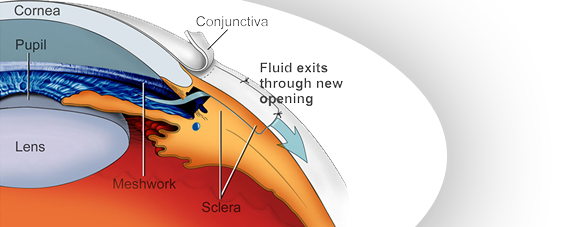Glaucoma Subspecialty
Laser Trabeculoplasty
Laser trabeculoplasty uses a very focused beam of laser light to treat the drainage angle of the eye. This procedure makes it easier for fluid to flow out of the front part of the eye, decreasing pressure in the eye. A special microscope (slit lamp) and lens (goniolens) are used to guide the laser beam to the canals (trabecular meshwork) where fluid drains from the eye.
 |
Filtration Surgery ( Trabeculectomy)
Trabeculectomy is used to treat open-angle glaucoma and chronic closed-angle glaucoma. It is usually done when medicine or laser treatment or both have failed to reduce the pressure in the eyes enough to prevent damage to a person's eyesight.
During trabeculectomy- sometimes also called filtration surgery- a piece of tissue in the drainage angle of the eye is removed, creating an opening. The opening is partially covered with a flap of tissue from the sclera and the conjunctiva. This new opening allows fluid (aqueous humor) to drain out of the eye, bypassing the clogged drainage channels of the trabecular meshwork.
During trabeculectomy- sometimes also called filtration surgery- a piece of tissue in the drainage angle of the eye is removed, creating an opening. The opening is partially covered with a flap of tissue from the sclera and the conjunctiva. This new opening allows fluid (aqueous humor) to drain out of the eye, bypassing the clogged drainage channels of the trabecular meshwork.
 |
Glaucoma Drainage Implant Surgery
Glaucoma drainage implants are small prosthetic devices that are placed to help lower the intraocular pressure and prevent further optic nerve damage. Glaucoma drainage implant surgery is an alternative to Glaucoma Filtration Surgery (Trabeculectomy). In some patients, particularly those with certain types of glaucoma such as aphakic glaucoma, neovascular glaucoma, and uveitic glaucoma, trabeculectomies are known to be less successful at reducing intraocular pressure due to an aggressive healing response. Also, in patients who have had other eye surgeries, a glaucoma drainage device often works better than a trabeculectomy procedure to control the intraocular pressure.
 |

